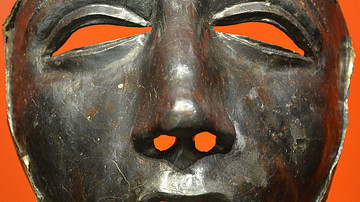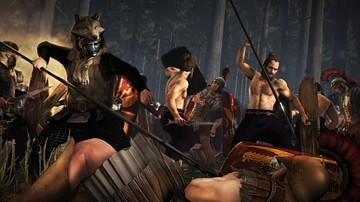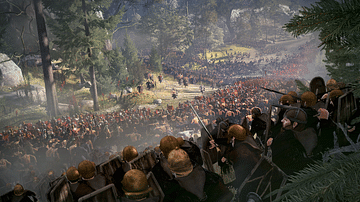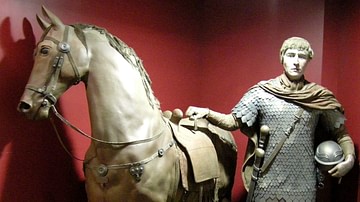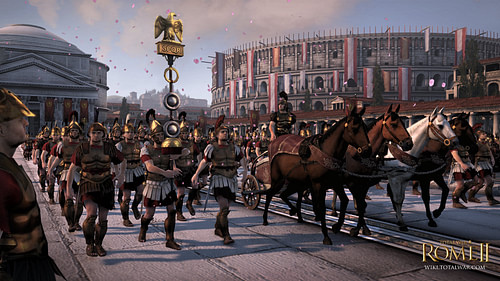
The Roman Standard (Latin: Signum or Signa Romanum) was a pennant, flag, or banner, suspended or attached to a staff or pole, which identified a Roman legion (infantry) or Equites (cavalry). The Standard of a cavalry unit was emblazoned with the symbol of the serpent (Draconarius) while a legion of infantry was represented by a totemic animal. The most famous of these is the eagle (Aquila) but there were also legions identified by the boar, the wolf, the horse, and minotaur.
The Standard was important as a rallying point, symbol of pride and, more practically, as a means of communication in battle. A trumpet blast would draw the attention of the troops to the Standard which would then direct which action should be taken on the field. The Standard bearer would lower, raise, wave, or make some other motion with the Standard to indicate what the next move was for the troops or to change some tactic or formation. So important was the Standard to the armies of Rome that battles were fought for their return. In the time of the Roman Republic the Standards were imprinted with the letters SPQR which was an abbreviation for Senatus Populusque Romanus (Senate and People of Rome). The Standard, then, represented not only the legion or cohort which carried it but the citizens of Rome, and the policies the army represented.
Besides the Serpent and Eagle symbols, there were also the Imago (a Standard displaying the image of the emperor), the Manus (an open hand at the top of the banner), the Vexillum (a rectangular cut cloth of a certain color, sometimes with a number, attached to a pole), and Banners which designated military hierarchy (a red banner, for example, would designate a general). The Vexillum designated the type of unit (legion or cohort) and which legion it was. The Manus of the open hand symbolized the loyalty of the soldiers and the trust they had in their leaders. The Imago reminded the troops of the emperor they fought for and symbolically stood for the will of Rome among them. A Standard would have more than one banner on it except for the Vexillum which was used to direct the troops' movements.
The story of the Battle of Teutoburg Forest (9 CE) and the Roman response to that defeat emphasizes the importance of the Standard to Rome. Under the reign of Augustus, in 12 BCE, the Roman legions were ordered into the region of Germania where they tried to accomplish what Julius Caesar had toyed with doing some forty years earlier: the subjugation of the land. Since the people of Germania were tribal, and there was no united front to wage war against, the armies of Rome could gain no foothold in the region. In 9 CE, the Roman general Quinctilius Varas was assigned the governorship of Germania, even though it was not conquered, and set about trying to collect taxes and tribute. This upset many of the populace, but especially a young German named Arminius who was a trusted member of Varus' staff. Arminius choreographed an elaborate plan by which the Roman legions would have to march through the Teutoburg Forest, where their tactics and training could little help them, and then ambushed them. The legions were massacred on the third day of their march and all three Standards were lost to Rome.
In c. 16 CE the Roman general Germanicus (15 BCE-19 CE) led his troops into Germania, in defiance of Augustus' dictate that the Rhine should be the boundary of Rome, to retrieve the Standards lost by Varas' defeat. Augustus was dead by then and Tiberius ruled Rome but, still, the previous boundary stood. Historians since have agreed that Germanicus' campaign was driven by revenge, his desire to rally the troops around him and, as a symbol of their personal loyalty to him and to Rome, the retrieval of the Standards. He massacred as many of the indigenous people as he could in retribution for the Roman defeat and recovered two of the three Standards lost in the Battle of Teutoburg Forest. While the people of Rome applauded his victories, he was denied advancement by Tiberius for acting outside of the established policy and also, no doubt, for engaging in a campaign which would have contributed to Germanicus' popularity at Tiberius' expense.
While not directly treating the Teutoburg Forest campaign, in the modern day Hollywood films such as Centurion (2010) and The Eagle (2011) have made much of the Roman Standard and its significance to the military, and the people, of ancient Rome. The Eagle, especially, addresses the so-called `Massacre of the Ninth Legion' in Britain and the loss of the Eagle Standard. In reality, there was most likely no massacre of the 9th legion. The most common date given for their disappearance is 117 CE, but extant Roman records show members of the 9th still in service after that date. If the 9th Legion was lost, then it was later than 117 CE, but it has been suggested that the 9th was disbanded and its soliders re-assigned to other legions. The loss of the Eagle of the Ninth Legion, however, remains a symbol of the spirit and vitality of the military unit it represented. The stories and films regarding attempts to find it celebrate the lengths to which one should go to preserve the honor of one's person, family, country, and brothers-in-arms and, whether those stories are true, they testify to the potent symbolism of the Roman Standard.

